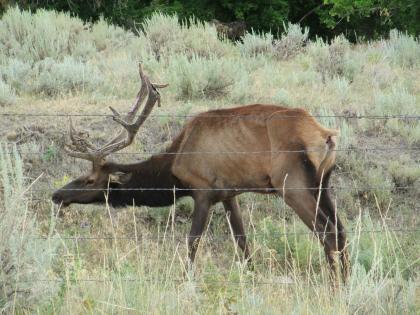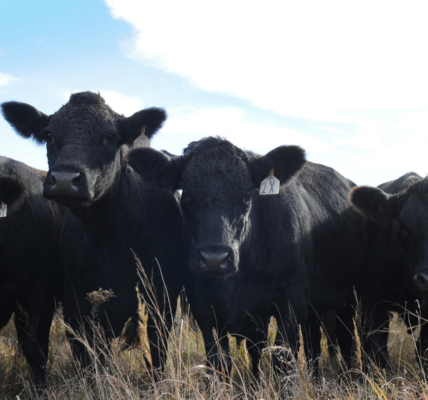
• As refuge mulls alternatives to reduce elk feeding, lawsuit from outfitters looms.
By Billy Arnold
Jackson Hole News&Guide
Via- Wyoming News Exchange
JACKSON — About an hour into a meeting last week about the future of feeding on the National Elk Refuge, biologists and outfitters hit an impasse.
The disagreement was about a number, an estimate of how prevalent chronic wasting disease would become in fed elk. The percentage of the herd infected with the always fatal neurological condition could determine how a given elk herd weathers the coming infectious storm, biologists say. But outfitters, pointing to herds elsewhere in the state, said they didn’t buy the experts’ assessment that up to 42% of elk in fed populations, like those on the refuge, could eventually become infected.
Things got heated, quickly.
“The experts are wrong,” BJ Hill shouted from the back of the room. Hill owns Swift Creek Outfitters and Teton Horseback Adventures.
The refuge’s senior wildlife biologist, Eric Cole retorted: “We’ll have to agree to disagree on that.”
Cole had just presented five different options for the future of feeding on the National Elk Refuge. Four will involve either reducing or eliminating feeding altogether in a bid to slow the spread of chronic wasting disease in Jackson Hole.
But the exchange highlights a central tension in the far-ranging debate about how to handle chronic wasting disease and feeding as it spreads through western Wyoming, the only place in the country with a formalized elk feeding program. Outfitters, who hunt refuge-fed elk every fall, don’t want to see feeding stop and have threatened lawsuits if it does. They also don’t buy the science biologists have put forward.
In short, they don’t believe that feeding presents a long-term risk, pointing to elk herds in eastern Wyoming where chronic wasting disease is significantly more prevalent and elk herds are still growing. The hunting outfitters also fundamentally mistrust the validity of forward-looking disease models that predict what would happen as CWD infects more Jackson-area ungulates. As the only area in the country where elk are regularly fed, and an area where CWD is just starting to take hold, they argue that stopping feeding now would certainly cause elk to starve and die, while the impacts of continued feeding are less certain.
“Nobody knows,” Sy Gilliland, of the Wyoming Outfitters and Guides Association, previously told the News&Guide. “There are no studies replicating what fed elk live through, or do in relation to CWD.”
But biologists say feeding does present a long-term risk, and that models, while uncertain, are instructive. Given that CWD is 100% fatal and can be transmitted between animals as well as from the environment to animals, there’s little room for error, according to experts.
“That’s what’s frustrating about this. We don’t get a do over,” Hank Edwards, the recently retired supervisor of the Wyoming Wildlife Health Laboratory, told the News&Guide after the meeting. “Does that mean we need to go crazy and shut all the feedgrounds off tomorrow? No, that’s not what I’m saying. But I think we need to take some proactive responses and limit environmental contamination.”
While fed elk populations in western Wyoming have not yet seen population declines due to chronic wasting disease, other elk herds have, like wapiti in South Dakota’s Wind Cave National Park. There, segments of the national park’s elk herd with the most chronic wasting disease (up to 29% prevalence) saw population declines.
Studies also show that fed elk gather in tighter quarters than unfed herds, increasing the risk of transmitting disease. That indicates fed elk are much more likely to spread chronic wasting disease either between animals or through the environment, where prions, the disease-causing agents, can live for up to 16 years.
All that underpins studies predicting that as chronic wasting disease expands in western Wyoming, elk populations will fall. A 2021 study, the first of its kind, predicted that, once CWD prevalence hits 7% in the Jackson Elk Herd, the population will decline with or without cow harvest.
A more recent study authored by U.S. Geological Survey scientists Jonathan Cook and Paul Cross predicts that, if feeding stops on state feedgrounds south of the National Elk Refuge, some elk would starve and die in the short run. But, if feeding continues down south, the study says elk populations would fall much farther in the future, depressing hunting opportunity and impacting the regional economy.
A similar study is being conducted for the refuge. “We’re conducting a similar analysis to what was conducted to the herd units south of Jackson,” Cole said. “Same players, same expert opinion, just different demographics and a higher proportion of the herd on feed.”
On Wednesday, mistrust of those experts bubbled over when Refuge Manager Frank Durbian said that chronic wasting disease prevalence for fed elk populations could hit 42%.
The expert panel from the Cook and Cross study, which consists of a handful of researchers from the U.S. Geological Survey, Wyoming Game and Fish Department, National Park Service, University of Wyoming and Montana Fish, Wildlife and Parks.
Outfitters were not pleased.
“We will sue this thing to the end. And we will appeal it and will appeal it,” Hill told refuge officials. “Because the resource cannot be dealing with these bogus modeling things you’re throwing up on the screen.”
Outfitters in the room fiercely debated the 42% estimate, pointing to the Laramie Peak Elk Herd in southeastern Wyoming, which is double the size managers want, despite CWD’s long-term presence in the population. In 2022, Game and Fish estimated that about 5.6% of the elk in the Laramie Peak herd had CWD, more than five times the best available estimate for prevalence in the Jackson Elk Herd.
“We’re being fed the deer prevalence figures for the Elk Refuge and that is absolutely incorrect,” Teton County outfitter Maury Jones said.
But Cole and two members of the expert panel — Edwards, Wyoming’s retired wildlife health expert, and Game and Fish’s Jackson-area disease biologist Ben Wise — said that’s not the case. Other free-ranging elk herds in Wyoming have higher rates of chronic wasting disease, including the Iron Mountain herd near Laramie, which had 14% prevalence in 2022. They also pointed to herds in South Dakota’s Wind Cave park, where prevalence has approached 30%. Captive populations at the Game and Fish Department’s Sybille wildlife research facility have also approached 100%, which biologists all said was an extreme that is unlikely in free-ranging, fed elk.
The 40% prevalence estimate was an attempt to split the difference between what wildlife managers have seen in wild elk and captive elk.
“It’s tough because all we know is the two ends of the spectrum: We know what captive herds will look like and we know what free-range herds will look like,” Wise told the News&Guide. “Personally, I don’t know if we will get to 42% in 20 years. But I definitely think it’s going to be above what we see in free-range populations.
“So I don’t know where that falls,” Wise added.
Edwards agreed with that assessment, arguing that the 42% prevalence estimate is a general idea of where fed elk populations could be headed, not exactly where they’re headed. He also said that, based on a study from Rocky Mountain National Park predicting population declines when prevalence hits 13%, he’s not surprised the Laramie Peak population is still growing. But he contrasted that with the Iron Mountain herd, where prevalence is about 13% and growth is slowing.
“Whether that’s due to CWD, there’s no way you can say that, especially when you’re at that cusp,” Edwards said, adding that it highlights a central challenge of studying disease.
“Being able to really identify cause-specific mortality in this herd is going to be really tough,” he said. “Prevalence is going to have to be higher until we can say that CWD is really having an impact.”
Wise and Cole said the Jackson Elk Herd also is different in one key way compared to the Laramie Peak herd: It’s far less productive. Cow-calf ratios in the Laramie herd are roughly double what they are in Jackson. And the Laramie herd has other advantages. Weather is better, the snowpack is not as deep, and there are fewer predators.
“There’s a lot of things that reduce the amount of wiggle room we have capacity-wise once CWD gets into the Jackson Elk Herd,” Wise said. “Once CWD reaches a certain point, just to maintain numbers, we’re going to have to curtail harvest because survival isn’t there and the reproductive rate isn’t there.”




